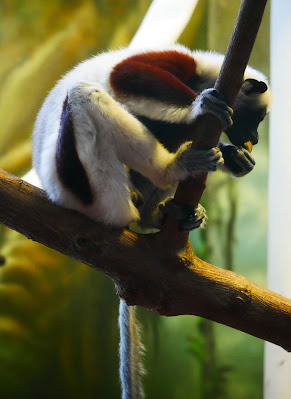The Philadelphia Zoo's PECO Primate Reserve has also had a bit of a baby boom with successful live births of an Orangutan, a White-Handed Gibbon and a White and Black Colobus. Sumatran Orangutan births are always a source of great celebration as the species is on the fast track to extinction. I was very fortunate to have gotten to see Sugi (born last June) on his first day outside last August. On this trip, the Orangutans weren't early risers, and so I got to watch the keepers prep their interior day room and then a single male emerged to have breakfast. I assume it was Jambi, but I don't know them well enough to know for certain.
The associated exterior yard with its humongous Sycamores was occupied on this morning by the family of White-handed Gibbons. The species is gender dimorphic meaning that males and females are different colors. The females are a blond/beige while the males a deep dark brown/black. Newborns tend to be dark brown and then morph up or down in color as they reach the end of their first year of life. The Philadelphia Zoo is home to a very successful breeding pair: 35-year-old female Phoenice and 34-year-old male Mercury. The birth of Eros on March 14th of this year brings their family of offsprings up to 3! Eros has both an older brother (Polaris, born in 2018), and an older sister (Ophelia, born in 2023).
The Stork's other delivery was a baby White and Black Colobus monkey on January 27th of this year. The happy parents are both 11-years-old and first timers. The mother is Tatu, and the father is Dexter--who was born at the Maryland Zoo in 2014! It's so exciting to see these connections between my beloved Maryland Zoo and others. The baby, Yeti, is a male.
During my visit, I was also able to see the Coquerel's Sifaka and Ring-tailed Lemurs and the Western Lowland Gorillas.
The Ring-tailed Lemur "Island"--that is actually a peninsula. You can see the line of bubbles in the water? This is strategic. It fools the Lemurs into thinking that a predator is lurking beneath them, and they never try to get in the water or jump away.
Ring-Tailed Lemur
Lemur catta
Tatu and Yeti awaiting the opening of the Habitat-Trail.
White and Black Colobus Guereza
Colobus guereza
A male enjoying the Habitat-trail over the Giant Tortoise yard.
Coquerel's Sifaka
Propithecus
Western Lowland Gorilla
Gorilla gorilla
White-Handed Gibbon
Hylobates lar
Sumatran Orangutan
Pongo abelii





















No comments:
Post a Comment